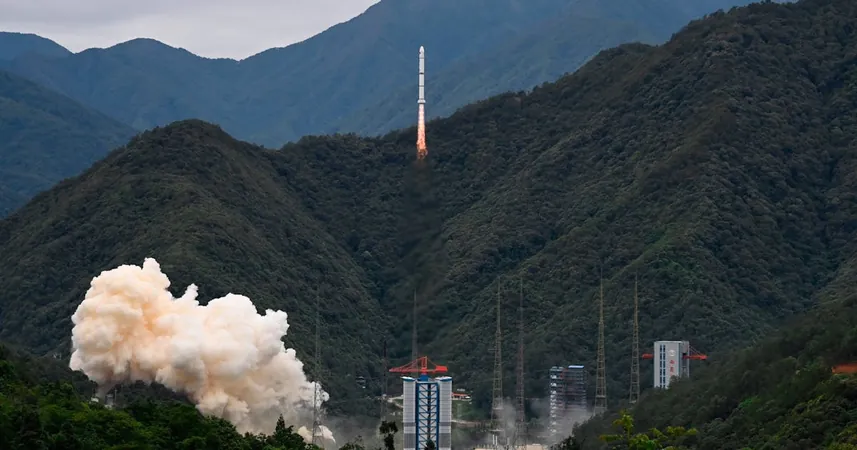
China’s Bold 25-Year Space Exploration Strategy: Aiming for Stardom by 2050!
2024-10-25
Author: Daniel
China’s Ambitious 25-Year Space Plan
China has officially unveiled an ambitious 25-year space exploration plan, signaling its determination to rise as a global leader in space by 2050 and establish itself as a formidable competitor to the United States. Experts and analysts are praising this strategic move, emphasizing its implications for international space dynamics.
Key Features of the Plan
The plan, co-published by the Chinese Academy of Sciences, the China National Space Administration, and the China Manned Space Agency, outlines five major scientific themes and 17 priority areas for breakthroughs. Key targets include searching for extraterrestrial life, exploring celestial bodies such as Mars, Venus, and Jupiter, sending crews to the moon, and constructing an international lunar research station by 2025.
Experts Weigh In
Clayton Swope, deputy director of the Aerospace Security Project at the Center for Strategic and International Studies, highlighted the plan's long-term vision. He noted, 'Experts were uncertain about China’s commitment to space exploration amid economic challenges, but this initiative confirms their dedication.'
Phased Exploration Goals
The plan details Beijing's intentions to send astronauts to the moon by 2030 and retrieve the first Martian samples, alongside ambitious missions to Jupiter. It is structured in three phases, each focused on distinct exploration goals.
National Pride and Global Technology Showcase
Analysts argue that this extensive plan serves not only to bolster national pride but also to showcase China’s technological capabilities on the global stage. Nicholas Eftimiades, a former senior intelligence officer, pointed out that space exploration elicits significant public interest and fosters a sense of nationalism among the Chinese people.
Historical Context of China’s Space Ambitions
Antonia Hmaidi, a senior analyst at the Mercator Institute for China Studies, added that China's space ambitions trace back to the 1960s and underscored the nation's record of successful space missions. Notable achievements include the Chang’e-4 mission, which made history with the first soft landing on the moon's far side, and the Tianwen-1 mission, which successfully placed China’s rover on Mars.
Continued Advancements and Challenges
In addition to lunar and Martian missions, China has launched numerous scientific satellites since 2011, aimed at expanding knowledge about dark matter and conducting quantum experiments. Despite these advancements, Swope cautioned that the U.S. still holds a significant advantage in many space metrics and scientific endeavors.
The U.S. Advantage in the Space Race
One of the critical factors behind the U.S.'s edge in space exploration is its thriving private aerospace sector. Eftimiades observed that American companies have leapfrogged ahead due to a dynamic private industry model, while China’s space programs are predominantly state-controlled, which can both streamline objectives and create bureaucratic challenges in cutting-edge technology development.
Current Launch Statistics and Competition
As of October 2023, China aimed to conduct 100 orbital launches within the year, yet it had completed 48 by mid-month. In stark contrast, American company SpaceX had already launched its 100th rocket and is poised to achieve even more this year.
Military Dimensions of China's Space Strategy
Meanwhile, the U.S. Department of Defense is taking significant steps to integrate commercial innovations into its military space strategy, recognizing the dual-use nature of many space technologies. Swope noted that there's a vast potential for these technologies to serve both scientific and military purposes.
The Dual Nature of China's Space Aspirations
Interestingly, Hmaidi pointed out that despite the focus on scientific exploration in the latest plan, there remains a strong undercurrent of military ambitions in China's broader space strategy. She indicated that this particular plan intentionally downplays military applications while likely overlooking initiatives like the low-earth orbit internet project that possess clear military utility.
Global Reactions and Future Outlook
China's extensive space plan is raising eyebrows within the global community. Will it succeed in closing the gap with the U.S., or could it outpace its competition entirely? Only time will tell if China can transform its stellar ambitions into reality. Stay tuned as we uncover the next phases in this riveting space race!


 Brasil (PT)
Brasil (PT)
 Canada (EN)
Canada (EN)
 Chile (ES)
Chile (ES)
 Česko (CS)
Česko (CS)
 대한민국 (KO)
대한민국 (KO)
 España (ES)
España (ES)
 France (FR)
France (FR)
 Hong Kong (EN)
Hong Kong (EN)
 Italia (IT)
Italia (IT)
 日本 (JA)
日本 (JA)
 Magyarország (HU)
Magyarország (HU)
 Norge (NO)
Norge (NO)
 Polska (PL)
Polska (PL)
 Schweiz (DE)
Schweiz (DE)
 Singapore (EN)
Singapore (EN)
 Sverige (SV)
Sverige (SV)
 Suomi (FI)
Suomi (FI)
 Türkiye (TR)
Türkiye (TR)
 الإمارات العربية المتحدة (AR)
الإمارات العربية المتحدة (AR)